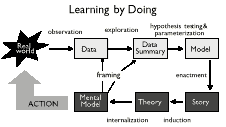
The Heart of Complexity
Complexity
Models + Hard Data =
Solutions to Hard Problems in Health Care
Kevin Dooley, Ph.D.
- How can we tell
stories with data? There are ways we can and cannot solve problems using
data.
 Consider
the Learning by Doing model (right). The missing link is, we're not
telling stories. We're not making the link between the model and the
system.
Consider
the Learning by Doing model (right). The missing link is, we're not
telling stories. We're not making the link between the model and the
system.
- As we tell stories, it helps to frame the world. However, we can also be biased by those frames.
- The Inverse Power
Law is a pervasive model in complex systems.
 The
Inverse Power Law says small stuff tends to happen a lot, big stuff
happens less frequently. This holds true for earthquakes, for example:
There are lots of small tremors, but few big disasters. It's true in
economic behavior: mostly a stable market with small fluctuations. In
evolution: Number of species going extinct is usually very few... but
occasionally it's a lot. It's also true in earth temperature changes,
music, energy dissipation and waves.
The
Inverse Power Law says small stuff tends to happen a lot, big stuff
happens less frequently. This holds true for earthquakes, for example:
There are lots of small tremors, but few big disasters. It's true in
economic behavior: mostly a stable market with small fluctuations. In
evolution: Number of species going extinct is usually very few... but
occasionally it's a lot. It's also true in earth temperature changes,
music, energy dissipation and waves.
- This same pattern keeps showing up in data. People have discovered several different stories in how the inverse power law comes out.
- If you drop grains
of sand on a table top, it will begin to self-organize into a sand pile.
But soon, you can't make the sand pile any higher -- it stays the same
height and eventually starts having avalanches. Additional grains of
sand you drop will usually have no effect. Many will displace just a
few other grains of sand. But sometimes, a single grain will make a
huge avalanche happen.
- Now think of the
avalanches as human behavior. As we look forward to massive connection
in our organizations with info technology... we're going past the point
of criticality -- like the sandpile that cannot grow in height any longer.
We don't need to be superconnected. Not everyone needs to know everything.
Intelligence in the future is knowing when not to connect.
- Conventional wisdom: If a catastrophe is happening, we look for a catastrophic cause. "What huge collapse in our system occurred?!" And maybe there is one. But it's also likely that it just happens. It's just that single extra grain of sand. By eliminating the causes of small problems, we can also eliminate the causes of severe "avalanches."
- We have a problem
with data. We spend all of our time collecting and summarizing it...
and no time modeling, story telling, and building theory.
- We are going 100%
in the wrong direction with our information systems. Companies are spending
billions of dollars, and most systems are failing. We need localized,
specialized information systems.
- Our health care
systems are complex adaptive systems... Are our Information Systems
CAS?
- Do they self-organize?
- Do they exhibit emergent behavior?
- Do they adapt to changes in environment?
- Do they hold
"multiple mental models" at once?
- We need a bit
more "profound knowledge" about statistics and complex systems
behavior in health care
- Current quality
and information systems may be woefully inadequate in their capability
to address complex problems in health care arena...
- We need look to
complexity for additional insights...
- Note that Kevin
Dooley's overheads can be found at: www.eas.asu.edu/~kdooley/vha98.ppt
- For more reading:
- Per Bak, How Nature Works
- West & Deering, The Lure of Modern Science: Fractal Thinking
Copyright
© 1999, VHA Inc. Permission
to copy for educational purposes only.